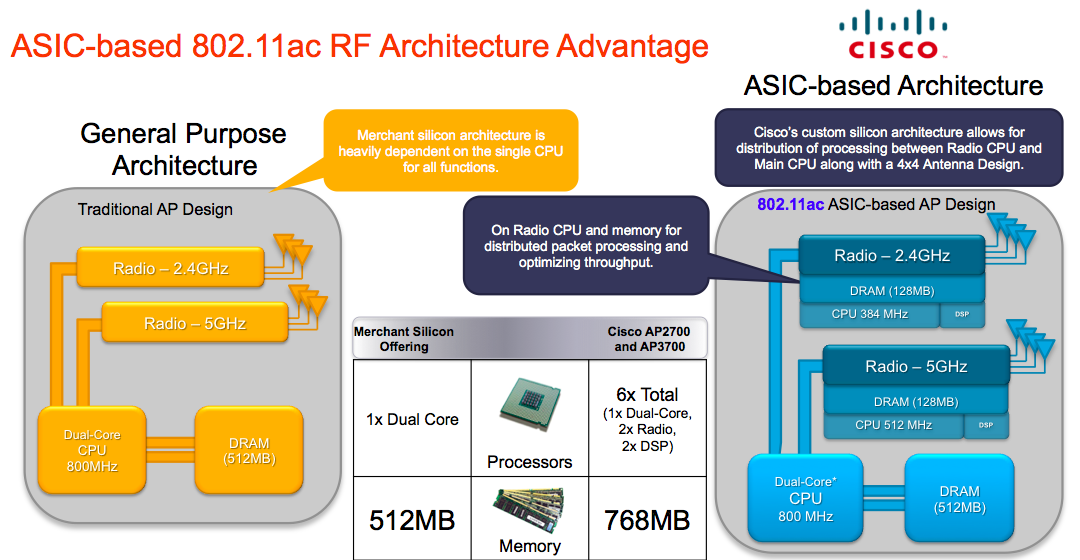































It's always interesting and often entertaining to observe how competitors promote their products and what they choose to focus on-and more importantly, what they choose not to focus on and what they hope people won't ask questions about.
Consider yet again how a competitor chooses to position their "purpose built" AP vs. the Cisco Aironet 3700 802.11ac Access Point Series.
This competitor frequently (and somewhat obsessively) points out that its 802.11ac AP has dual "active" 800 MHz cores while the Cisco AP3700 has only one "active" 800 MHz core. This is not completely true since it completely overlooks the fact that the Cisco AP3700 also has a dedicated CPU core and DSP foreachradio subsystem.
Furthermore, it also overlooks that the dual "active" cores in the competitor's APshare512 MB of DRAM. The single "active" core of the AP3700 hasdedicated512 MB of DRAM. Also each radio subsystem has adedicated128 MB DRAM (for 768 MB total DRAM in the AP3700).

Why is all of this important?Keep in mind that the "purpose" of "building" an access point is as a highly specialized computing and communications device, designed for forwarding packets between wired and wireless LANs. The optimal AP implementation should be targeted at forwarding those packets in the most efficient way possible (i.e., high throughput and low latency). The benefits for this "built-for-purpose" design would be to address head-on:
? High client density as the new norm for WLAN networks
? Intermittent peak demand which is tough to predict
? Headroom in the infrastructure to tackle flash crowds
This "built for purpose" AP3700 really shines in maintaining .11ac performance even as the number of clients increases. The competitor arch won't keep up with increasing number of 11ac clients and high client density environments.
What prevents efficiency? Poor architecture. In the competitor's case, the memory and memory bus are a shared resource. In order to share memory equitably or fairly, one needs to devote time towards managing that memory (bus contention and arbitration, scheduling, multiplexing, etc.). As one can easily understand -and stated very simply -a consequence of sharing is that something needs to wait while that shared resource is in use, occupied, or busy with something else. So why share a resource when you can afford not to? And in fact should not do so given the purpose and design objectives.
In other words, why build an AP using a classic, "general purpose" computer architecture, embedded or otherwise? One should be investing in efficient packet forwarding, not memory management and build an AP that meets the high density and performance needs (or challenges) of 802.11ac.
One should also be investing in a product architecture that meets the high density challenges of 802.11ac while also scaling for future needs. This is another "built for purpose" ASIC-based architecture for which the AP 3700 was built with modularity in mind.
When considering
In closing, there's a lot more to designing and building an access point than simply focusing on the clock speed or the number of processors. Of course, as a consequence there's also a lot more to think about when choosing which AP to invest in. More information is better than less -ask those hard questions and demand the full story.
 Tags chauds:
informatique
802.11ac
access point
architecture
11ac
A/S
client
ASIC
compute
Tags chauds:
informatique
802.11ac
access point
architecture
11ac
A/S
client
ASIC
compute